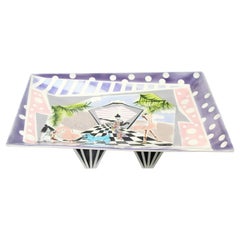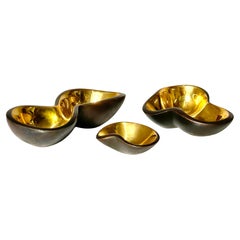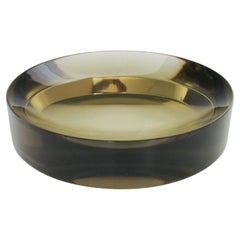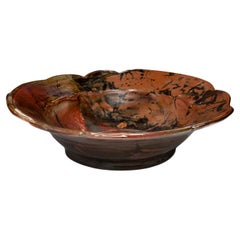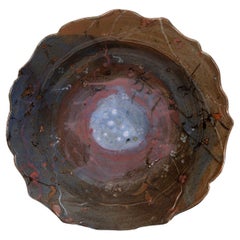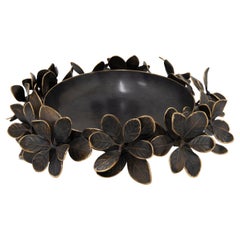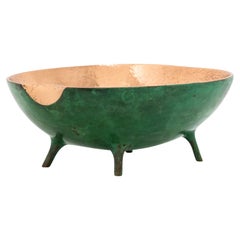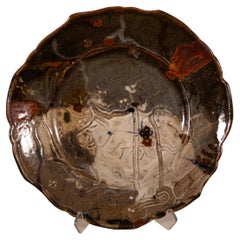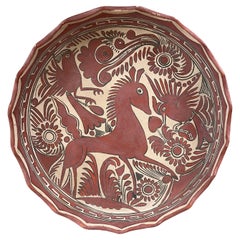Michigan Decorative Dishes and Vide-Poche
to
12
1
12
1
5
6
1
3
3
2
8
3
2
2
1
2,801
1,679
11
11
1
1
Height
to
Width
to
13
13
13
5
1
1
1
1
Item Ships From: Michigan
Contemporary Modern Rike Moss Signed Ceramic Pottery Centerpiece Tray Legs 1980s
Located in Keego Harbor, MI
For your consideration is a fun, ceramic art tray centerpiece, signed Rike Moss on the bottom, circa 1980s. In very good vintage condition, with a couple small chips in two corners. ...
Category
1980s Vintage Michigan Decorative Dishes and Vide-Poche
Materials
Ceramic
Set of 3 Bronze & Gold Biomorphic Decorative Bowl Sculptures by Jonathan Adler
By Jonathan Adler
Located in Troy, MI
A grouping of 3 bronze biomorphic decorative bowls by Jonathan Adler
Retired design model 13020 circa 2012
Graduated size and varied organic forms in bronze with gold interior
Impre...
Category
2010s American Modern Michigan Decorative Dishes and Vide-Poche
Materials
Bronze
Ward Bennett vide-poche polished green tone glass dish
By Brickel Associates, Ward Bennett
Located in Ferndale, MI
Simple and elegant concave dish designed by Ward Bennett . Highly polished top and underside glass with a green tint . No nicks in glass . Minor scuffs on underside .
Born in 1917, W...
Category
Mid-20th Century American Mid-Century Modern Michigan Decorative Dishes and Vide-Poche
Materials
Glass
Severa Made in Italy Enameled Modern Ceramic Fish Design Elongated Plate
Located in Keego Harbor, MI
A decorative mid century modern enameled ceramic glazed elongated plate with a fish design. Stamped “Severa” and “Made in Italy” on the bottom. The plate could also be used to hold a...
Category
20th Century Italian Michigan Decorative Dishes and Vide-Poche
Materials
Ceramic
John Glick Plum Street Pottery Ceramic Glazed Bowl/Charger Extra-large
By John Glick
Located in Bloomfield Hills, MI
The ceramic bowl is an example of the kind of work by which John Glick became so famous. He was seduced by the effects of the reduction kiln, which decreased the levels of oxygen during firing, inducing the flame to pull oxygen out of the clay and glazes changing the colors of the glazes depending on their iron and copper content. In this way he achieved the rich gradients of ochre and umber and variations in stippling and opacity. It is signed by the artist and stamped with Plum Street Pottery on the verso.
John was an American Abstract Expressionist ceramicist born in Detroit, MI. Though open to artistic experimentation, Glick was most influenced by the styles and aesthetics of Asian pottery—an inspiration that shows in his use of decorative patterns and glaze choices. He has said that he is attracted to simplicity, as well as complexity: my work continually reflects my re-examination that these two poles can coexist… or not, in a given series. Glick also took influences from master potters of Japan, notably Shoji Hamada and Kanjrio Kawai, blending their gestural embellishments of simple forms with attitudes of Abstract Expressionism. He was particularly drown to the work of Helen Frankenthaler whose soak-stain style resonated with Glick’s multi-layered glaze surfaces, which juxtaposed veils of atmospheric color with gestural marks and pattern. He spent countless hours developing and making his own tools in order to achieve previously unseen results in his work with clay and glaze.
Glick’s “Plum Tree Pottery” (now a designated historic landmark in Farmington Hills, Michigan) studio opened around 1965 and closed in the summer of 2016. It was a private studio space for John and a number of his students and assistants. He believed his shapes evolved guided by forces apparently outside his control. This was instinctual, intellectual and due to his openness to change, fusing into what he thought was the most positive force behind a potter’s approach: evolution and growth. Some have called it inspiration.
John was not only a major figure in the Detroit creative community, but in the ceramics world at large. According to Shelley Selim in her book on John, “John Glick: A Legacy in Clay” John remains: “one of the most recognizable names in the field of studio pottery – known for lecturing, publishing, and offering workshops widely – and his work has been featured in well over a hundred local, national and international exhibitions since he was a college student in the late 1950s.” Along with this John has mentored over thirty studio apprentices over five and a half decades, received numerous grants and awards for his work, and has been prolific, with an estimated 300,000 ceramic wares throughout the world.
He received his Masters from Cranbrook Academy of Art in Bloomfield Hills, Michigan, working with Maija Grotell, a legendary and influential teacher. Grotell was noted for her deep interest in the human connection to nature’s rhythms and patters. These ideas often grounded her dialog with her students including Glick, affecting, a profund and lasting influence on his future work. This famous Art Academy was designed by architect and faculty member, Eliel Saarinen who collaborated with Charles and Ray Eames on chair and furniture design. Numerous creative artists who are alumni of Cranbrook include: Harry Bertoia, Florence Knoll, Jack Lenor Larsen, Donald Lipski, Duane Hanson, Nick Cave, Hani Rashid, George Nelson, Urban Jupena (Nationally recognized fiber artist), Artis Lane (the first African-American artist to have her sculpture, "Sojourner Truth," commissioned for the Emancipation Hall in the Capital Visitor Center in Washington DC), Cory Puhlman (televised Pastry Chef extraordinaire), Thom O’Connor (Lithographs), Paul Evans (Brutalist-inspired sculpted metal furnishings), Eugene Caples (small bronze images/abstract), Morris Brose (Bronze Sculptures), Herb Babcock (blown glass), Larry Butcher (mixed media) and Lauren Anais Hussey...
Category
Late 20th Century American Michigan Decorative Dishes and Vide-Poche
Materials
Ceramic
John Glick Plum Street Pottery Signed Monumental Ceramic Charger
By John Glick
Located in Bloomfield Hills, MI
The ceramic charger with scalloped edge is an example of the kind of work by which John Glick became so famous. He was seduced by the effects of the reduction kiln, which decreased the levels of oxygen during firing, inducing the flame to pull oxygen out of the clay and glazes changing the colors of the glazes depending on their iron and copper content. In this way he achieved the rich gradients of ochre and umber and variations in stippling and opacity. It is signed on verso.
John was an American Abstract Expressionist ceramicist born in Detroit, MI. Though open to artistic experimentation, Glick was most influenced by the styles and aesthetics of Asian pottery—an inspiration that shows in his use of decorative patterns and glaze choices. He has said that he is attracted to simplicity, as well as complexity: my work continually reflects my re-examination that these two poles can coexist… or not, in a given series. Glick also took influences from master potters of Japan, notably Shoji Hamada and Kanjrio Kawai, blending their gestural embellishments of simple forms with attitudes of Abstract Expressionism. He was particularly drown to the work of Helen Frankenthaler whose soak-stain style resonated with Glick’s multi-layered glaze surfaces, which juxtaposed veils of atmospheric color with gestural marks and pattern. He spent countless hours developing and making his own tools in order to achieve previously unseen results in his work with clay and glaze.
Glick’s “Plum Tree Pottery” (now a designated historic landmark in Farmington Hills, Michigan) studio opened around 1965 and closed in the summer of 2016. It was a private studio space for John and a number of his students and assistants. He believed his shapes evolved guided by forces apparently outside his control. This was instinctual, intellectual and due to his openness to change, fusing into what he thought was the most positive force behind a potter’s approach: evolution and growth. Some have called it inspiration.
John was not only a major figure in the Detroit creative community, but in the ceramics world at large. According to Shelley Selim in her book on John, “John Glick: A Legacy in Clay” John remains: “one of the most recognizable names in the field of studio pottery – known for lecturing, publishing, and offering workshops widely – and his work has been featured in well over a hundred local, national and international exhibitions since he was a college student in the late 1950s.” Along with this John has mentored over thirty studio apprentices over five and a half decades, received numerous grants and awards for his work, and has been prolific, with an estimated 300,000 ceramic wares throughout the world.
He received his Masters from Cranbrook Academy of Art in Bloomfield Hills, Michigan, working with Maija Grotell, a legendary and influential teacher. Grotell was noted for her deep interest in the human connection to nature’s rhythms and patters. These ideas often grounded her dialog with her students including Glick, affecting, a profund and lasting influence on his future work. This famous Art Academy was designed by architect and faculty member, Eliel Saarinen who collaborated with Charles and Ray Eames on chair and furniture design. Numerous creative artists who are alumni of Cranbrook include: Harry Bertoia, Florence Knoll, Jack Lenor Larsen, Donald Lipski, Duane Hanson, Nick Cave, Hani Rashid, George Nelson, Urban Jupena (Nationally recognized fiber artist), Artis Lane (the first African-American artist to have her sculpture, "Sojourner Truth," commissioned for the Emancipation Hall in the Capital Visitor Center in Washington DC), Cory Puhlman (televised Pastry Chef extraordinaire), Thom O’Connor (Lithographs), Paul Evans (Brutalist-inspired sculpted metal furnishings), Eugene Caples (small bronze images/abstract), Morris Brose (Bronze Sculptures), Herb Babcock (blown glass), Larry Butcher (mixed media) and Lauren Anais Hussey...
Category
1990s American Expressionist Michigan Decorative Dishes and Vide-Poche
Materials
Ceramic
Studio Pottery Blue and Black Splatter Glazed Slab Bowl
Located in Ferndale, MI
Eye-catching Modern with a Mid Century vibe. Two blue corners with black splatters and two corners in white with black drip glaze lines. Attributed to Jack Charney of Santa Fe.
Category
Late 20th Century American Modern Michigan Decorative Dishes and Vide-Poche
Materials
Pottery
Bovano bright iridescent fused glass on copper charger or serving try
By Bovano
Located in Ferndale, MI
Large size Bovine serving tray or charger . Fused glass on copper .
The history of Bovano of Cheshire began in 1952, when artist Jim Bower began experimenting with powdered glass fu...
Category
Mid-20th Century American Mid-Century Modern Michigan Decorative Dishes and Vide-Poche
Materials
Copper, Enamel
John Glick Plum Street Pottery Ceramic Charger Monumental
By John Glick
Located in Bloomfield Hills, MI
The ceramic charger is an example of the kind of work by which John Glick became so famous. He was seduced by the effects of the reduction kiln, which decreased the levels of oxygen during firing, inducing the flame to pull oxygen out of the clay and glazes changing the colors of the glazes depending on their iron and copper content. In this way he achieved the rich gradients of ochre and umber and variations in stippling and opacity. It is signed by the artist and stamped with Plum Street Pottery on the verso.
John was an American Abstract Expressionist ceramicist born in Detroit, MI. Though open to artistic experimentation, Glick was most influenced by the styles and aesthetics of Asian pottery—an inspiration that shows in his use of decorative patterns and glaze choices. He has said that he is attracted to simplicity, as well as complexity: my work continually reflects my re-examination that these two poles can coexist… or not, in a given series. Glick also took influences from master potters of Japan, notably Shoji Hamada and Kanjrio Kawai, blending their gestural embellishments of simple forms with attitudes of Abstract Expressionism. He was particularly drown to the work of Helen Frankenthaler whose soak-stain style resonated with Glick’s multi-layered glaze surfaces, which juxtaposed veils of atmospheric color with gestural marks and pattern. He spent countless hours developing and making his own tools in order to achieve previously unseen results in his work with clay and glaze.
Glick’s “Plum Tree Pottery” (now a designated historic landmark in Farmington Hills, Michigan) studio opened around 1965 and closed in the summer of 2016. It was a private studio space for John and a number of his students and assistants. He believed his shapes evolved guided by forces apparently outside his control. This was instinctual, intellectual and due to his openness to change, fusing into what he thought was the most positive force behind a potter’s approach: evolution and growth. Some have called it inspiration.
John was not only a major figure in the Detroit creative community, but in the ceramics world at large. According to Shelley Selim in her book on John, “John Glick: A Legacy in Clay” John remains: “one of the most recognizable names in the field of studio pottery – known for lecturing, publishing, and offering workshops widely – and his work has been featured in well over a hundred local, national and international exhibitions since he was a college student in the late 1950s.” Along with this John has mentored over thirty studio apprentices over five and a half decades, received numerous grants and awards for his work, and has been prolific, with an estimated 300,000 ceramic wares throughout the world.
He received his Masters from Cranbrook Academy of Art in Bloomfield Hills, Michigan, working with Maija Grotell, a legendary and influential teacher. Grotell was noted for her deep interest in the human connection to nature’s rhythms and patters. These ideas often grounded her dialog with her students including Glick, affecting, a profund and lasting influence on his future work. This famous Art Academy was designed by architect and faculty member, Eliel Saarinen who collaborated with Charles and Ray Eames on chair and furniture design. Numerous creative artists who are alumni of Cranbrook include: Harry Bertoia, Florence Knoll, Jack Lenor Larsen, Donald Lipski, Duane Hanson, Nick Cave, Hani Rashid, George Nelson, Urban Jupena (Nationally recognized fiber artist), Artis Lane (the first African-American artist to have her sculpture, "Sojourner Truth," commissioned for the Emancipation Hall in the Capital Visitor Center in Washington DC), Cory Puhlman (televised Pastry Chef extraordinaire), Thom O’Connor (Lithographs), Paul Evans (Brutalist-inspired sculpted metal furnishings), Eugene Caples (small bronze images/abstract), Morris Brose (Bronze Sculptures), Herb Babcock (blown glass), Larry Butcher (mixed media) and Lauren Anais Hussey...
Category
1990s American Expressionist Michigan Decorative Dishes and Vide-Poche
Materials
Ceramic
John Glick Plum Street Pottery Ceramic Charger Monumental
By John Glick
Located in Bloomfield Hills, MI
The ceramic charger is an example of the kind of work by which John Glick became so famous. He was seduced by the effects of the reduction kiln, which decreased the levels of oxygen during firing, inducing the flame to pull oxygen out of the clay and glazes changing the colors of the glazes depending on their iron and copper content. In this way he achieved the rich gradients of ochre and umber and variations in stippling and opacity. It is signed by the artist and stamped with Plum Street Pottery #129 on the verso.
John was an American Abstract Expressionist ceramicist born in Detroit, MI. Though open to artistic experimentation, Glick was most influenced by the styles and aesthetics of Asian pottery—an inspiration that shows in his use of decorative patterns and glaze choices. He has said that he is attracted to simplicity, as well as complexity: my work continually reflects my re-examination that these two poles can coexist… or not, in a given series. Glick also took influences from master potters of Japan, notably Shoji Hamada and Kanjrio Kawai, blending their gestural embellishments of simple forms with attitudes of Abstract Expressionism. He was particularly drown to the work of Helen Frankenthaler whose soak-stain style resonated with Glick’s multi-layered glaze surfaces, which juxtaposed veils of atmospheric color with gestural marks and pattern. He spent countless hours developing and making his own tools in order to achieve previously unseen results in his work with clay and glaze.
Glick’s “Plum Tree Pottery” (now a designated historic landmark in Farmington Hills, Michigan) studio opened around 1965 and closed in the summer of 2016. It was a private studio space for John and a number of his students and assistants. He believed his shapes evolved guided by forces apparently outside his control. This was instinctual, intellectual and due to his openness to change, fusing into what he thought was the most positive force behind a potter’s approach: evolution and growth. Some have called it inspiration.
John was not only a major figure in the Detroit creative community, but in the ceramics world at large. According to Shelley Selim in her book on John, “John Glick: A Legacy in Clay” John remains: “one of the most recognizable names in the field of studio pottery – known for lecturing, publishing, and offering workshops widely – and his work has been featured in well over a hundred local, national and international exhibitions since he was a college student in the late 1950s.” Along with this John has mentored over thirty studio apprentices over five and a half decades, received numerous grants and awards for his work, and has been prolific, with an estimated 300,000 ceramic wares throughout the world.
He received his Masters from Cranbrook Academy of Art in Bloomfield Hills, Michigan, working with Maija Grotell, a legendary and influential teacher. Grotell was noted for her deep interest in the human connection to nature’s rhythms and patters. These ideas often grounded her dialog with her students including Glick, affecting, a profund and lasting influence on his future work. This famous Art Academy was designed by architect and faculty member, Eliel Saarinen who collaborated with Charles and Ray Eames on chair and furniture design. Numerous creative artists who are alumni of Cranbrook include: Harry Bertoia, Florence Knoll, Jack Lenor Larsen, Donald Lipski, Duane Hanson, Nick Cave, Hani Rashid, George Nelson, Urban Jupena (Nationally recognized fiber artist), Artis Lane (the first African-American artist to have her sculpture, "Sojourner Truth," commissioned for the Emancipation Hall in the Capital Visitor Center in Washington DC), Cory Puhlman (televised Pastry Chef extraordinaire), Thom O’Connor (Lithographs), Paul Evans (Brutalist-inspired sculpted metal furnishings), Eugene Caples (small bronze images/abstract), Morris Brose (Bronze Sculptures), Herb Babcock (blown glass), Larry Butcher (mixed media) and Lauren Anais Hussey...
Category
1990s American Expressionist Michigan Decorative Dishes and Vide-Poche
Materials
Ceramic
Concentric Ring Turned Wood Maple Platter or Charger Attributed to Russel Wright
By Russel Wright
Located in Ferndale, MI
Nicely turned maple wood charger. Concentric ring design in the manner of Russel Wright.
Category
Mid-20th Century American Organic Modern Michigan Decorative Dishes and Vide-Poche
Materials
Maple
John Glick Modernist Stoneware Glazed Ceramic Pottery Tea Pot Plum Tree Pottery
By John Glick
Located in Keego Harbor, MI
A modernist stoneware glazed ceramic tea pot by Detroit artist John Glick of Plum Tree Pottery. Circa late 20th century. Glazed in earthtones. Artisisnal yet functional and makes a u...
Category
Mid-20th Century American Michigan Decorative Dishes and Vide-Poche
Materials
Ceramic
Well Crafted Hammered Copper Boomerang Dish Signed LE
Located in Ferndale, MI
Very nicely made and crafted boomerang or flying V-form hammered copper bowl.
Category
Mid-20th Century American Mid-Century Modern Michigan Decorative Dishes and Vide-Poche
Materials
Copper
Related Items
Large Handmade Cast Bronze Kathal Leaves Decorative Bowl Sculpture
By Alguacil & Perkoff Ltd.
Located in London, GB
Unique and exquisite bronze cast leaf bowl. Handmade using highly skilled and specialised traditional processes to create an original and sumptuous piece.
Slight variations in the p...
Category
2010s Indian Organic Modern Michigan Decorative Dishes and Vide-Poche
Materials
Brass, Bronze
Verdigris Bronze Decorative Bowl with Legs, Vide-Poche
By The Design Foundry
Located in London, GB
Charming and unusual handmade polished cast bronze bowl.
Each of these original and elegant bowl is handmade individually. Cast using very traditional te...
Category
2010s Indian Organic Modern Michigan Decorative Dishes and Vide-Poche
Materials
Bronze
Extra Large Bowl in Selenite
By Kathryn McCoy
Located in West Hollywood, CA
Indulge in the captivating allure of Kathryn McCoy's Rock Crystal Collection, a masterpiece that seamlessly blends nature's raw beauty with exquisite craftsmanship. Available in vari...
Category
21st Century and Contemporary American Modern Michigan Decorative Dishes and Vide-Poche
Materials
Rock Crystal
Postmodern Artist Made Ceramic Bowl, Signed Terry 1980s
Located in Miami, FL
Artist made coil and pinch ceramic bowl, signed Terry, circa 1980s
pink with blue splatter glaze.
Category
Late 20th Century American Post-Modern Michigan Decorative Dishes and Vide-Poche
Materials
Ceramic
Decorative Hand Painted Italian Ceramic Fish Plate by DeSimone
By Giovanni de Simone
Located in San Diego, CA
Beautiful decorative hand painted Italian ceramic fish plate by DeSimone, circa 1960s The plate is in great condition with no chips or cracks and very light wear. It is signed and nu...
Category
Mid-20th Century Italian Mid-Century Modern Michigan Decorative Dishes and Vide-Poche
Materials
Ceramic
Ambrosiá Handmade Crystal Decorative Bowl Set: Arcaico modern crystal bowl
Located in Glendale, CA
The Ambrosiá Footed Crystal Bowl Set is a Multifunctional Luxury Serveware.
It is a handcrafted, collectible centerpiece that beautifully merges vi...
Category
2010s Modern Michigan Decorative Dishes and Vide-Poche
Materials
Crystal
$488 Sale Price / item
20% Off
H 9.3 in W 5.5 in D 5.5 in
Decorative Bowl Centerpiece Vessel Sculpture White Calacatta Marble Handmade
By Barberini & Gunnell, Pieruga Marble
Located in Ancona, Marche
Gondola, big elegant bowl, hand-sculpted from a solid block of Calacatta marble.
Bowl dimensions: Big L 65 x W 13 x H 11 cm.
Also available: Small L 55 x W 12 x H 9.5 cm.
Available...
Category
21st Century and Contemporary Italian Modern Michigan Decorative Dishes and Vide-Poche
Materials
Marble
$1,922 / item
H 4.34 in W 5.12 in D 25.6 in
CHIMBORAZO Decorative Volcanic Stone Bowl with Bronze Detail by ANDEAN, In Stock
By Alejandro Moyano (ANDEAN)
Located in Quito, Pichincha
Decorative volcanic stone hand-carved bowl from Chimborazo volcano, with lathed bronze base.
Drawing inspiration from the sacral and baroque motifs of Quito, as well as Ecuador’s hi...
Category
2010s Ecuadorean Modern Michigan Decorative Dishes and Vide-Poche
Materials
Stone, Bronze
On Hold
$350 / item
H 2.37 in Dm 8.47 in
Jonathan Adler Hand-Thrown Vase
By Jonathan Adler
Located in Philadelphia, PA
Jonathan Adler Hand-Thrown and painted 14" tall vase. Nice condition with one very small rim chip as seen in photo.
Category
1980s American Modern Vintage Michigan Decorative Dishes and Vide-Poche
Materials
Ceramic
Contemporary LAAB Moss Bowl Ceramic Raku Green White
By LAAB Milano
Located in monza, Monza and Brianza
Moss Bowl
A visually impressive yet soft play of shades describes the mesmerizing flair of this spectacular bowl, marked by a natural white color enriched...
Category
21st Century and Contemporary Italian Modern Michigan Decorative Dishes and Vide-Poche
Materials
Ceramic
Ceramic Hippo Plate, Hand made in South Africa
By Zimele Ceramics
Located in North Miami, FL
Introducing the Hippo Plate, a stunning ceramic creation by the acclaimed Nompilo Zaba, hand-sculpted by Victor Shabalala, and crafted at Zimele Ceramics in South Africa. Measuring 1...
Category
21st Century and Contemporary South African Modern Michigan Decorative Dishes and Vide-Poche
Materials
Ceramic
Turned Biomorphic Walnut Bowl by Rude Osolnik
By Rude Osolnik
Located in Ferndale, MI
Turned biomorphic walnut bowl, Rude Osolnik Originals.
Category
1960s American American Craftsman Vintage Michigan Decorative Dishes and Vide-Poche
Materials
Walnut
Previously Available Items
John Glick Plum Tree Charger Plate Pottery Mid Century Modern
By John Glick
Located in Keego Harbor, MI
Discover this captivating Mid Century Modern Plum Tree Charger Plate by the renowned potter John Glick. This artistic ceramic plate is a conve...
Category
Mid-20th Century Unknown Mid-Century Modern Michigan Decorative Dishes and Vide-Poche
Materials
Ceramic
1970s Art Nouveau Style Mexican Pottery Tri-Legged Plate
Located in Ferndale, MI
Mexican Art Nouveau flora and fauna three legged shallow bowl with scalloped edge. Beautifully painted terra cotta horse as a center point, surrounded by birds and flowers with black...
Category
1970s Art Nouveau Vintage Michigan Decorative Dishes and Vide-Poche
Materials
Pottery, Paint
Joseph Quillian Limited Signed Bronze Turtle Dish and Bronze Turtle Sculptures
Located in Keego Harbor, MI
A Joseph Quillian bronze turtle dish with set of three "Flipper, Tripper, and Crasher" individual baby turtle sculptures. All scupltures are individually s...
Category
20th Century Michigan Decorative Dishes and Vide-Poche
Materials
Bronze
H 3.5 in W 11.5 in D 17.25 in
Biomorphic Ashtray, Vide Poche, Sculpture by Arno Scheiding
Located in Ferndale, MI
A green and brown biomorphic ashtray sculpture designed by Arno Scheiding.
Signed Arno Scheiding T-704
Category
Mid-20th Century North American Mid-Century Modern Michigan Decorative Dishes and Vide-Poche
Materials
Pottery
Steuben Glass Rare Nimbus Dish
By Steuben Glass
Located in Keego Harbor, MI
This sleek Steuben crystal nimbus dish is the perfect addition to any home. Featuring an elegant, modern design, this stunning piece will bring a touch of sophistication to your decor. This curved bowl gives the effect of a double stacked bowl...
Category
Late 20th Century Michigan Decorative Dishes and Vide-Poche
Materials
Glass
Contemporary Modern Glass Art Barrett Circle Charger Plate Stand
Located in Keego Harbor, MI
For your Consideration a beautiful fused glass Barrett circle charger plate and stand. Dimensions: Plate on stand: 18.5" diameter x 3" height Stand: 11" W x 10" D x 2" H.
Category
Early 2000s Michigan Decorative Dishes and Vide-Poche
Materials
Art Glass
Vintage Mid-Century Modern Ritts Astrolite Lucite Acrylic Bowl Dish Large
Located in Keego Harbor, MI
For your consideration is this stunning vintage Ritts Astrolite acrylic lucite dish/bowl measuring 17 W x 15 D x 6.25 H.
Category
Mid-20th Century Michigan Decorative Dishes and Vide-Poche
Materials
Lucite
Set of Six Kay Bojeson Turned Teak Wood Cover Plates Denmark
By Kay Bojesen
Located in Ferndale, MI
Six Danish cover plates stamped Kay Bojeson Denmark teak. Lathe turned dishes.
Category
Mid-20th Century Danish Mid-Century Modern Michigan Decorative Dishes and Vide-Poche
Materials
Teak
Lalique Paris Signed Crystal Charger Plate Cote D'or French Greco Roman Nudes
By Lalique
Located in Keego Harbor, MI
For your consideration is an incredible and sensual, crystal charger with Greco Roman nudes engraved in the glass, "Cote D'or," signed Lalique Paris. ...
Category
20th Century Michigan Decorative Dishes and Vide-Poche
Materials
Glass
Maison Jansen Style Faux Tortoise Shell Lucite Tray with Nickel Handles
By Maison Jansen
Located in Troy, MI
Found in Italy, this circa 1970s Maison Jansen style midcentury tray is made of Lucite with a faux tortoise finish and polished nickel handles. Unknown m...
Category
Mid-20th Century European Mid-Century Modern Michigan Decorative Dishes and Vide-Poche
Materials
Nickel
H 2.25 in W 20.25 in D 14.75 in
Contemporary Memphis R&J Thomas 459 Textured Glass Centerpiece
Located in Keego Harbor, MI
For your consideration is an vibrant and fun, textured glass art bowl or centerpiece with stand, signed R&J Thomas 459. In excellent condition. The dimensions...
Category
1980s Vintage Michigan Decorative Dishes and Vide-Poche
Materials
Glass
Contemporary Modern Fujimori Humoresque Coll. Kato Kogei Set 12 Art Plates 1980s
By Kato Kogei
Located in Keego Harbor, MI
For your consideration is a fun, geometric set of twelve porcelain art plates, from the Fujimori collection by Kato Kogei, made in Japan, stamp...
Category
1980s Japanese Vintage Michigan Decorative Dishes and Vide-Poche
Materials
Porcelain
H 1 in W 10.5 in D 7.5 in
Recently Viewed
View AllMore Ways To Browse
Dry Bar With Stools 3
Dutch Clog
Egyptian Granite
Elephant Howdah
Enamel Peacock Feather
English Chinoiserie Chest
English Oak Gateleg Table
Etienne Henry
Fantastic Planet
Faux Book Box
Faux Tortoise Tray
Flamingo Animal Sculptures
Flemish Cabinets 17th Century
Fox Figurine
Fox Hunt Plate
French Art Deco Rosewood Buffet
French Bonbonniere
French Bulldog Gold
